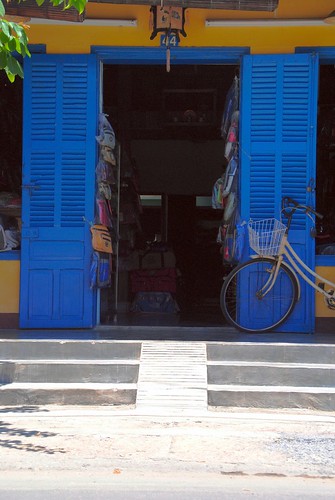
Vietnam was a French colony for most of its modern history prior to the Vietnam war, and French influence is still strong throughout the country. Nowhere in Vietnam is this influence more pronounced than in the town of Hoi An, located on the central Vietnamese coast near the large city of Da Nang.
Hoi An is a relaxing place to stop for a few days as you travel north or south through Vietnam. But it’s also a marvelous intersection of Vietnam’s French-colonial past and the local culture that has been sustaining people long before the arrival of the French, all in a beautiful coastal setting.
Hoi An is near the coast, but not exactly on it. Rather, the town sits on the banks of the Thu Bon River, a waterway that is not only beautiful, but life-sustaining.
Although you will probably arrive in Hoi An in the late morning, do yourself a favor and wake up early the first morning you wake up in Hoi An. Walk or bike over to the river and take in sunrise with the locals.

A morning market along the Thu Bon
When I say “life-sustaining,” I mean it. As this scene from a river market depicts, the river is a central part not only of culture in Hoi An, but also a source of sustenance for the local community. The riverbank is where fisherman deposit their catches early in the morning, and where their family members set up markets to sell the portions of their bounties they don’t personally need throughout the day.

Hoi An’s colorful cityscape
In general, the further away you get from the river, the more pronounced the French influence in Hoi An becomes. The architectural style of buildings in Hoi An is decidedly French, although the color selections and bougainvillea vines growing over the buildings gives them a flair that’s hard to mistake for anywhere but Vietnam.

Hoi An is home to a number of permanent shops, in addition to street markets like you find in the rest of Vietnam
Although Hoi An is extremely small — you can literally walk across the entire town in 20 minutes, and that’s if you’re moving slowly — it is home to a number of permanent storefronts, and not just the collapsible markets that dominate much of Vietnam. Some Hoi An travelers associate this architectural style with commercialization but to me, it gives the town an Old World stateliness that’s intoxicating.

Head east over the Thu Bon River once you finish exploring Hoi An’s town center
You could conceivably spend your entire time in Hoi An exploring the town center, but why? I encourage you to rent a bike, either from your hotel or from any of the several bike rental facilities in Hoi An, and head east over the Thu Bon River. Many delights await you on the other side!

The further away you bike from Hoi An, the more tropical your settings become
Indeed, Hoi An is so small that the scene just a few minutes outside the town limits is almost completely tropical and uninhabited. Whether you’ve been traveling in Vietnam for a week or a month, this tranquility will be welcome, as if Hoi An’s compact size and laid-back energy weren’t refreshing enough.

Eventually, you will arrive at An Bang beach, one I found to be much more popular among locals than tourists
Approximately 20 minutes’ ride eastward from Hoi An’s town center is an actual beach! Not only is An Bang Beach relatively undeveloped, extremely clean and pin-drop quite, but when I was there anyway, the crowd was decidedly more local than tourist. I don’t know if I would bank on this being the case for you, however, with how booming Vietnam’s tourism industry is at the moment.

A tiger lantern on the Thu Bon river at night
Head back to Hoi An’s center at night to see the town — and, as you see, the river — quite literally lit up. Even if animal lanterns like this tiger aren’t present when you’re there (I believe this was part of a special festival), you can still shop for colorful lamps and lanterns at stalls on the east bank of the river.

Robert Schrader is a travel writer and photographer who’s been roaming the world independently since 2005, writing for publications such as “CNNGo” and “Shanghaiist” along the way. His blog, Leave Your Daily Hell, provides a mix of travel advice, destination guides and personal essays covering the more esoteric aspects of life as a traveler.








